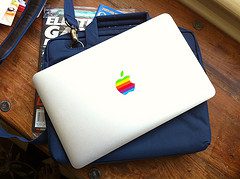

The MacBook Air 2011 does not come with an installation CD or USB stick, and, as mentioned in a previous post, does not (for the moment) work with the standard version of Lion which Apple sells in their store, or any version of Snow Leopard. So, what happens if you need to reinstall your operating system?
As it turns out, there are two built-in methods of reinstalling. One is the recovery partition. The other is Internet recovery. (Both require internet access, however.)
As part of Lion installation, a small partition of the drive is created which contains “Mac OS X Utilities”. This the same program that runs when you boot a Lion install disk directly, and which lets you restore from Time Machine, go to Disk Utililty, etc.
You access this partition by either holding down cmd-R during startup, or by holding down option and choosing the partition from among the bootable volumes. If you elect to install (or reinstall) Lion, the actual Lion installer is first downloaded from the internet; the computer then reboots to continue the installation.
If there is no recovery partition — say, for example, because you replaced the stock SSD a higher-capacity internal SSD, and it sees no other bootable partitions, when you hold down option at startup it will say “network install” and give you a popup to join a WiFi network. When you do this, it downloads the contents of the recovery partition to a RAM disk, letting you then use Disk Utility and/or kick off the Mac OS X installation process.
I’ll just repeat that again: the new MacBook Airs (and the new Mac mini) can, with a completely bare hard drive, go out on the internet and get what it needs to install the whole operating system. It’s built into the machine itself. That’s super cool.
Image by blakespot, from Flickr Creative Commons.